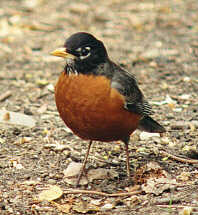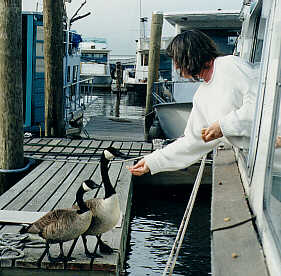The City Naturalist
Observing Birds
by Leslie Day

Spring
In April and May, birds such as the Baltimore oriole, wood thrush and eastern phoebe migrate north along the Atlantic Coast Flyway and land in Central Park to feed. Many birds use Central Park as their summer breeding grounds such as the pair of Mute swans that raise their baby swans or cygnets on the Lake.
Summer
April through August birds nest and raise their young. Look for song birds such as the baby American robin, northern cardinal and European starlings who follow their parents "peeping" and lowering their wings in begging postures.
 Look for baby waterfowl such as mute swan cygnets, and
mallard ducklings
who follow their parents single file across the meer, the lake or
the ponds in Central Park.
Look for baby waterfowl such as mute swan cygnets, and
mallard ducklings
who follow their parents single file across the meer, the lake or
the ponds in Central Park.
A pair of Red-tailed hawks built their nest and raised their young on a Fifth Avenue building. Other red-tails hunt and soar over Riverside Park.
When the honeysuckle and other flowering plants bloom look for ruby throated hummingbirds sipping nectar from the wildflowers.
Fall
In September many of our songbirds that feed on insects, such as American redstarts, scarlet tanagers and red breasted grosbeaks, migrate to warmer areas, where food is plentiful. Waterfowl, such as the belted kingfisher , that depend on aquatic insects, fish, amphibians or aquatic vegetation also migrate south looking for open water on which to feed.
Winter
 A number of songbirds such as white-throated sparrows,
tufted titmice, juncos, house
sparrows, starlings, blue jays, and cardinals
either come down from more northern climes to feed on tree seeds
in the park, or live in our parks year-round. In Central Park,
the bird feeders at Azalea Pond in the Ramble are stocked with
bird seed throughout the winter. People who love birds will often
put seed out for them under street trees or in back yards
throughout this season of ice and snow. If the winter isn't too
cold and the park ponds, lakes and rivers don't freeze you can
find a number of waterfowl like Canada
geese and mallard
ducklings.
A number of songbirds such as white-throated sparrows,
tufted titmice, juncos, house
sparrows, starlings, blue jays, and cardinals
either come down from more northern climes to feed on tree seeds
in the park, or live in our parks year-round. In Central Park,
the bird feeders at Azalea Pond in the Ramble are stocked with
bird seed throughout the winter. People who love birds will often
put seed out for them under street trees or in back yards
throughout this season of ice and snow. If the winter isn't too
cold and the park ponds, lakes and rivers don't freeze you can
find a number of waterfowl like Canada
geese and mallard
ducklings.
How to observe birds
- It’s hard to see birds when the trees are covered with leaves
- Use your ears to detect where birds are
- Follow the sound with your eyes
- Walk quietly up to tree or ground where bird song or sound is coming from. Don’t go too close or the bird will fly away.
- First use your eyes, then use binoculars to have a good look at bird
Good Birding Spots In Central Park
 The Harlem Meer
The Harlem Meer
The Harlem Meer, especially during the winters that it does not freeze, attracts waterfowl year round. When this body of fresh water was rebuilt in l993, it was stocked with thousands of fish. The fishing and diving birds such as Cormorants, Great White Egret, Black-Crowned Night Heron and numerous ducks, geese and swans come to the Harlem Meer to feed, nest and raise their young during the different seasons.
The Pool and The Ravine
Few people know about or have been to this idyllic body of water that stretches from l00th Street to l03rd Street along Central Park West. The pool drains eastward, through a series of waterfalls, and then it turns into the Ravine, a creek that meanders into the Harlem Meer. The Pool has numerous fish and attracts all kinds of waterfowl during the warm months. The Ravine is quite shallow in places, and songbirds enjoy bathing in it during the spring and summer. There are also fish, tadpoles and crayfish for the fishing birds to feed on.
The Ramble and Azalea Pond
Azalea Pond in The Ramble has numerous bird feeders which are stocked throughout the year, so that the birds always have food-- even in the seasons of ice and snow. The Ramble itself, which has diverse habitats: woods, meadows and water (Azalea Pond and The Lake), attracts many birds year round.
Good Birding Spots In Riverside Park
79th Street Boat Basin, The Hudson River
Many residents of the 79th Street Boat Basin feed the birds year round. There are several people who live or work on the Upper West Side that come down to the river on a daily basis to feed the birds. During the severe winters of l994 and l996 when the river iced up, waterfowl congregated at the marina by the hundreds in response to winter feeding and protection. Because of the numbers of birds that live in or around the marina, one can frequently see birds of prey such as the Red-Tailed Hawk and the American Kestrel.
Where to Look
| Bird Habitats | What Birds to Look For |
|---|---|
| In the trees perched on branches you will find song birds eating seeds and insects. | American goldfinch black capped chickadee song sparrow |
| On tree trunks, climbing up, down or scurrying around the bark, you will find birds searching for insects in bark crevices or drilling holes in the trees as they look for insects. | downy woodpecker white breasted nuthatch brown creeper |
| Soaring high in the sky, you will see birds of prey. You may also see flocks of birds or birds singly or in family groups flying from one feeding spot to another, or migrating over Central Park. Look up! | Red-tailed hawks |
| On the ground under trees, you will find song birds scratching in the soil and turning over leaves looking for insects and worms. | Robins Wood thrushes |
| In the meadow you will find song birds such as the singing from the tops of fence posts and trees. | Rose-breasted grosbeak Song sparrow Cardinal |
| On the edges where habitats come together, for example: where the woods meat the lake shore, you will find many species of birds. | Red wing
blackbird Cedar waxwing |
| Skimming over the water you will find birds catching insects that hover over ponds, lakes and streams. | Barn swallows |
| Paddling on the lake, pond or stream you will find waterfowl. | Mallard
ducks Mute Swans. |
| Some birds dabble, or go upside down with their tails in the air and their webbed feet paddling to keep them upended, and use their bills to catch snails, tadpoles, small fish and underwater vegetation. It’s fun to watch them dabble, and dive completely underwater in search of fish. You might see a cormorant with a fish in its mouth as it surfaces. | Cormorants Canvasback Ducks Bufflehead ducks |
| Standing on the shore, you will find the wading birds such as the holding still as a statue looking for fish, tadpoles and frogs. Watch them as they slowly stalk their prey and lunge forward to catch a fish in their long sharp beaks. | Black
crowned night heron Great white heron |
About Leslie Day | For Further Information
Copyright © 1996-2012 The 79th Street Boat Basin Flora and Fauna Society.
